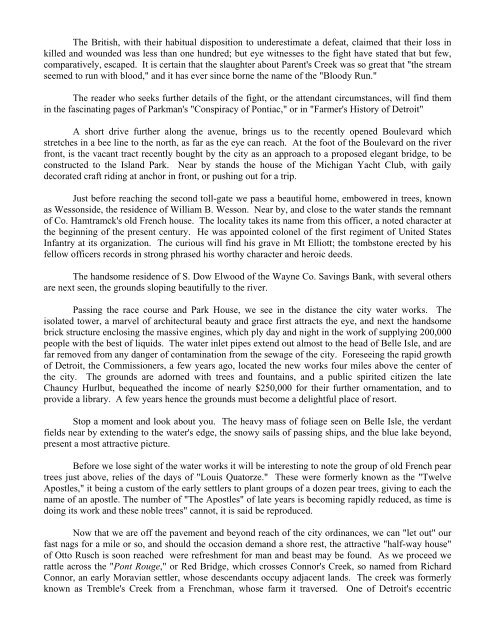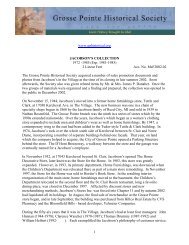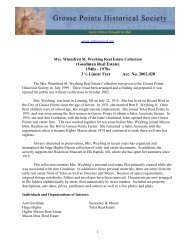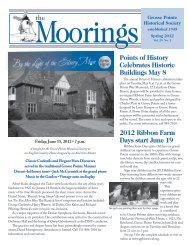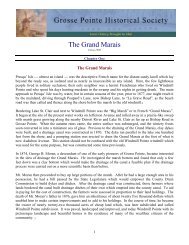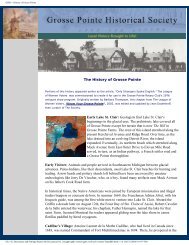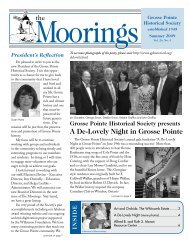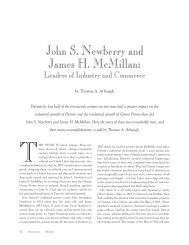Download - Grosse Pointe Historical Society
Download - Grosse Pointe Historical Society
Download - Grosse Pointe Historical Society
You also want an ePaper? Increase the reach of your titles
YUMPU automatically turns print PDFs into web optimized ePapers that Google loves.
The British, with their habitual disposition to underestimate a defeat, claimed that their loss in<br />
killed and wounded was less than one hundred; but eye witnesses to the fight have stated that but few,<br />
comparatively, escaped. It is certain that the slaughter about Parent's Creek was so great that "the stream<br />
seemed to run with blood," and it has ever since borne the name of the "Bloody Run."<br />
The reader who seeks further details of the fight, or the attendant circumstances, will find them<br />
in the fascinating pages of Parkman's "Conspiracy of Pontiac," or in "Farmer's History of Detroit"<br />
A short drive further along the avenue, brings us to the recently opened Boulevard which<br />
stretches in a bee line to the north, as far as the eye can reach. At the foot of the Boulevard on the river<br />
front, is the vacant tract recently bought by the city as an approach to a proposed elegant bridge, to be<br />
constructed to the Island Park. Near by stands the house of the Michigan Yacht Club, with gaily<br />
decorated craft riding at anchor in front, or pushing out for a trip.<br />
Just before reaching the second toll-gate we pass a beautiful home, embowered in trees, known<br />
as Wessonside, the residence of William B. Wesson. Near by, and close to the water stands the remnant<br />
of Co. Hamtramck's old French house. The locality takes its name from this officer, a noted character at<br />
the beginning of the present century. He was appointed colonel of the first regiment of United States<br />
Infantry at its organization. The curious will find his grave in Mt Elliott; the tombstone erected by his<br />
fellow officers records in strong phrased his worthy character and heroic deeds.<br />
The handsome residence of S. Dow Elwood of the Wayne Co. Savings Bank, with several others<br />
are next seen, the grounds sloping beautifully to the river.<br />
Passing the race course and Park House, we see in the distance the city water works. The<br />
isolated tower, a marvel of architectural beauty and grace first attracts the eye, and next the handsome<br />
brick structure enclosing the massive engines, which ply day and night in the work of supplying 200,000<br />
people with the best of liquids. The water inlet pipes extend out almost to the head of Belle Isle, and are<br />
far removed from any danger of contamination from the sewage of the city. Foreseeing the rapid growth<br />
of Detroit, the Commissioners, a few years ago, located the new works four miles above the center of<br />
the city. The grounds are adorned with trees and fountains, and a public spirited citizen the late<br />
Chauncy Hurlbut, bequeathed the income of nearly $250,000 for their further ornamentation, and to<br />
provide a library. A few years hence the grounds must become a delightful place of resort.<br />
Stop a moment and look about you. The heavy mass of foliage seen on Belle Isle, the verdant<br />
fields near by extending to the water's edge, the snowy sails of passing ships, and the blue lake beyond,<br />
present a most attractive picture.<br />
Before we lose sight of the water works it will be interesting to note the group of old French pear<br />
trees just above, relies of the days of "Louis Quatorze." These were formerly known as the "Twelve<br />
Apostles," it being a custom of the early settlers to plant groups of a dozen pear trees, giving to each the<br />
name of an apostle. The number of "The Apostles" of late years is becoming rapidly reduced, as time is<br />
doing its work and these noble trees" cannot, it is said be reproduced.<br />
Now that we are off the pavement and beyond reach of the city ordinances, we can "let out" our<br />
fast nags for a mile or so, and should the occasion demand a shore rest, the attractive "half-way house"<br />
of Otto Rusch is soon reached were refreshment for man and beast may be found. As we proceed we<br />
rattle across the "Pont Rouge," or Red Bridge, which crosses Connor's Creek, so named from Richard<br />
Connor, an early Moravian settler, whose descendants occupy adjacent lands. The creek was formerly<br />
known as Tremble's Creek from a Frenchman, whose farm it traversed. One of Detroit's eccentric


